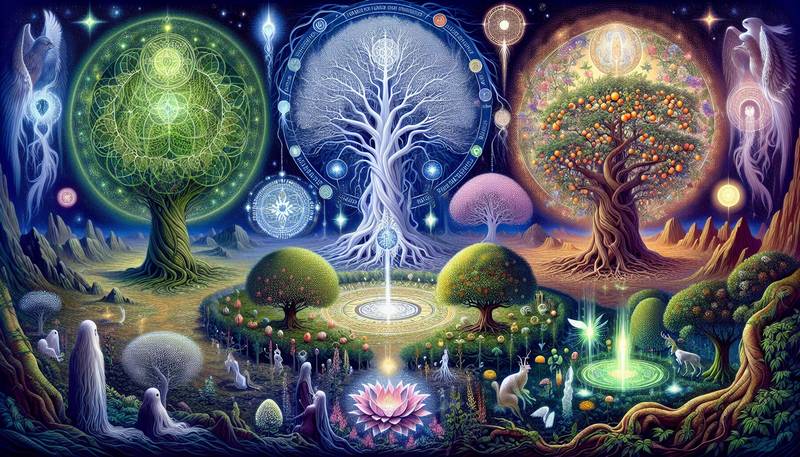Mythical Flora: Plants Steeped in Legend and Lore

Introduction: The Vegetative Vortex of Myth and MagicPlant life has long held a special place in the annals of human folklore and mythology. From the forbidden fruit in the Garden of Eden to the mighty Yggdrasil, the ash tree of Norse cosmology, we've woven fantastic tales of greenery imbued with potent symbolism, enchanting properties, and even supernatural powers. Some of these mythical plants, though entirely fictional, offer valuable insights into our cultural heritage and collective unconscious. Others, surprisingly, have roots in reality, and their real-life counterparts can be found in botanical gardens and nature reserves across the globe. This article will take you on a whirlwind tour of the world's most legendary foliage, with a light dusting of practical advice on how to keep your day job while indulging your passion for enchanted flora.Mandrake: The Screaming Baby RootLet's begin our botanical journey with the mandrake, a plant celebrated for both its healing properties and its chilling, mythical associations. This small, perennial herb, native to the Mediterranean and Middle East, bears fruit similar to a tomato and has a root system that, when unearthed, bears a striking resemblance to a small, contorted human figure. In ancient times, it was believed that the mandrake would emit a blood-curdling shriek if anyone attempted to pull it from the ground, a cry so devastating that it could kill or madden those who heard it. To safely harvest this valuable root, one needed to tie a dog to the plant and then toss a stone or some other noise-making device away to coax the dog to tug the plant free, at the unfortunate cost of the dog's life.In reality, the mandrake's roots contain potent alkaloids that can induce hallucinations, drowsiness, or even death in high enough doses. It was widely used in ancient medicine as an anesthetic and aphrodisiac, but beware: Today, possession of a mandrake plant in some countries can lead to legal troubles, as the plant is considered a dangerous narcotic. Best to stick to rubber replicas and Harry Potter memorabilia if you're keen on cultivating a mandrake collection.The Lotus-Eaters and Their Dreamy DelicacyMoving eastward, we encounter the lotus plant, an aquatic perennial revered in ancient Egypt, India, and China for its symbolic associations with purity, enlightenment, and rebirth. The lotus also plays a starring role in Homer's epic poem, "The Odyssey," in which the hero Odysseus and his crew encounter a tribe of people who subsist entirely on the lotus plant. The lotus-eaters, as they're called, live in a perpetual state of blissful, dreamy stupor, entirely uninterested in the trials and tribulations of the outside world. When some of Odysseus' men sample the plant themselves, they're instantly overtaken by the same languid indifference and must be hauled back to the ship by force.While the lotus plant does indeed contain psychoactive compounds that can induce feelings of relaxation and mild euphoria, it's unlikely that anyone could build a sustainable existence purely on lotus consumption. Nonetheless, the lotus-eaters' story serves as a cautionary tale about the dangers of excessive escapism and the importance of maintaining a balanced diet, both literally and metaphorically.Moly: The Magical AntidoteContinuing our exploration of Greco-Roman plant lore, we stumble upon moly, another enigmatic herb mentioned in "The Odyssey." According to the tale, the god Hermes gifts Odysseus with a sprig of moly as a protective talisman against the enchantments of the sorceress Circe. This magical plant, described as having a black root and a white flower, allows Odysseus to resist Circe's spells and ultimately win her favor and aid in his journey home.Despite centuries of speculation, the true identity of moly remains uncertain. Some botanists and classicists argue that it's a member of the garlic family, while others propose it's a type of orchid or even a purely fictional creation. Whatever the case, moly's legendary status as a symbol of divine protection and inner strength endures in the hearts and minds of plant enthusiasts and literature buffs alike.Yggdrasil: The World TreeFinally, we arrive at perhaps the most majestic and imposing of all mythical flora: Yggdrasil, the World Tree of Norse mythology. This enormous, evergreen ash tree serves as the axis mundi of the cosmos, with its roots extending deep into the realms of the dead and its branches stretching high into the heavens, connecting and sustaining all of creation. Yggdrasil is home to various fantastical creatures, including dragons, eagles, and stags, and its well-being is intimately linked to that of the entire universe.Although we may never discover a real-life tree that lives up to Yggdrasil's grandeur, this magnificent arboreal myth has inspired countless works of art, literature, and even video games. It also serves as a poignant reminder of our interconnectedness with the natural world and the profound, enduring impact that plants have on our lives, both as sources of sustenance and as wellsprings of wonder and imagination.Conclusion: Embracing the Green, Enchanted ThicketWhile many mythical plants may never grace the pages of a botanical encyclopedia, they remain firmly rooted in our cultural and psychological landscape. By exploring the legends and lore surrounding these fantastical flora, we can deepen our appreciation for the natural world and the richness of human creativity. So go ahead, plant a seed of curiosity, and watch as it grows into a towering, leafy cathedral of enchanted knowledge.
|
|







